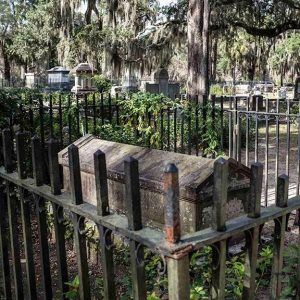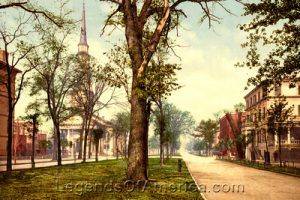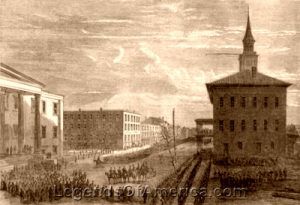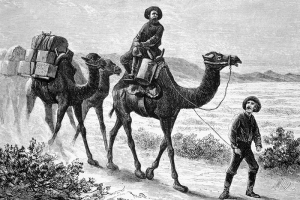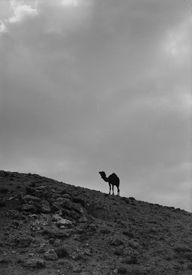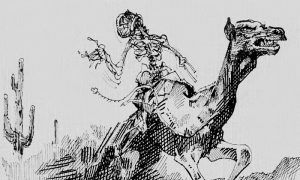Like many historic cities, and especially one that was called home to Abraham Lincoln for years, Springfield, Illinois continues to play host to a number of unearthly spirits.
The Ghost of Abraham Lincoln
While there are a number of spirits who are said to haunt this historic town, the most famous is that of Abraham Lincoln himself. According to over a century of legends, Abraham Lincoln continues to lurk around his tomb, now a state historic site in Springfield.
Sightings of the former president have been told almost since the day his body arrived in Springfield in on May 3, 1865. After lying in state at the capitol for a night, the body was placed in a receiving vault at Oak Ridge Cemetery. In December Lincoln’s remains were removed to a temporary vault not far from a new proposed memorial site. In 1871, three years after laborers had begun constructing the permanent tomb, the body of Lincoln and those of the three youngest of his sons were placed in crypts in the unfinished structure.
The construction of the permanent tomb lasted for years and it was at this time that the first sightings of a spectral Abraham Lincoln were reported as he wandered near the crypt. Others would report hearing the sounds of crying and footsteps near the site.
Lincoln Monument at the Oak Ridge Cemetery, Springfield, Illinois.
Lincoln Monument at the Oak Ridge Cemetery, Springfield, Illinois.
In 1874, upon completion of the memorial, Lincoln’s remains were interred in a marble sarcophagus in the center of a chamber known as the “catacombs,” or burial room. In 1876, however, after several Chicago criminals broke into the tomb, intending to kidnap the corpse and hold it for ransom. However, the attempt failed as one of the men in the gang was a spy for the Secret Service.
Over the years, the legends have persisted as tourists and staff members report uncomfortable feelings, phantom footsteps, whispers, muffled voices, and weeping. Along with our former president, Oakridge Cemetery also has reported that the apparitions of a small boy and a mysterious woman in a flowing red cape have been seen on the property.
Lincoln has also been reported to have been seen walking the streets surrounding Springfield‘s original courthouse, as well as the hallways of his former home. Others have reported seeing the ghost of Mary Lincoln at their old home located at 413 South Eighth Street. Having a long-standing reputation as being haunted, reports range from apparitions of a woman to toys moving of their own accord. Most people believe that the house is haunted by Mary. Maintained by the National Park Service today, the staff denies any reports of paranormal activity. Today the Lincoln home is the centerpiece of the Lincoln Home National Historic Site. Restored to its 1860s appearance, it stands in the midst of a four-block historic neighborhood in which the National Park Service also restored.
The most interesting haunting surrounding Lincoln is the phantom funeral train. Said to be seen during the month of April on the anniversary of Lincoln’s death, the ghostly train is said to ride those very same tracks that bore his body to Springfield in 1865. Reports indicate that this ghostly funeral procession is actually two trains, with the first steam engine pulling several cars draped in black, adorned with black streamers, and playing the sounds of mournful music. The second train is said to pull a flatcar that carries Lincoln’s coffin. Unfortunately, the train is said to never reach its final destination.
Dana House
Dana House, Springfield, Illinois courtesy the Illinois Times.
Dana House, Springfield, Illinois courtesy the Illinois Times.
Designed and constructed by renowned architect, Frank Lloyd Wright in 1902, this house is reported to still play host to its original owner. Designed for Springfield socialite, Susan Lawrence Dana, she was said to have thrown lavish parties in her home as well as being a major contributor and volunteer to charitable causes in the city.
Shortly after the home was finished, several family deaths caused Dana to turn to metaphysical and mystical religious groups for comfort. Before long, she became one of the city’s leaders in the Spiritualist movement that swept across American around the turn of the century. Her parties took a different turn with her involvement in the movement and soon her home became a Spiritualist center where séances were common and large parties of occultists gathered.
Finally, when a cousin who had lived with her for many years died, Susan was left alone in her Wright-designed house. A short time later, about 1928, Susan moved to more modest, less costly quarters. Declared incompetent by the courts in 1942, she was admitted to a local hospital, where she died in 1946. Her personal effects were inventoried in 1942 and auctioned at a public sale in July 1943. Her Frank Lloyd Wright House was sold the following year.
Maintained today by the State of Illinois, management denies any paranormal activity. However, there have been dozens of reports by other staff and visitors of objects which move of their own accord and the sounds of unseen people speaking in different parts of the house.
The Dana House is located at 301 East Lawrence in Springfield, Illinois.
Illinois Executive Mansion
Governors Mansion in Springfield, Illinois.
Governors Mansion in Springfield, Illinois.
Seven Presidents, including Lincoln, have been received here. Three levels are open to the public including four formal parlors; a state dining room; ballroom; four bedrooms, including the Lincoln bedroom; and a library handcrafted from Native American Black Walnut.
Built in 1855, this is the third oldest continuously occupied Governor’s Mansion in the country, having served as the official residence of Illinois‘ Governors and their families since Governor Joel Matteson first took up residence. Over the years, the magnificent home has been witness to many of the major events in the state’s history, none so trying perhaps as the Civil War.
During the Civil War, the mansion was called home to Governor Richard Yates and his family. Today, the mansion is said to continue to play host to Yates’ wife, Catherine. Mrs. Yates makes allegedly makes her presence known in a variety of ways, including tampering with electronics and smoke alarms. The upstairs bedroom where her portrait hangs is said to be the most active room in the house. On one occasion Mrs. Yates was credited with trapping an Illinois State Trooper in an elevator for four hours.
The Illinois Executive Mansion is open to the public during certain hours and days of the week. Three levels can be viewed which include four formal parlors, a state dining room, ballroom, the library, and four bedrooms, including the Lincoln bedroom. The mansion is located at 5th and Jackson.
Springfield Theatre Center
Built in 1951, the Springfield Theatre Center hosted performances at 101 East Lawrence through 2004 when they relocated to the Hoogland Center for the Arts in downtown Springfield. In addition to numerous wonderful performances throughout the years, the place is said to have been haunted for most of its existence.
On May 13, 1955, an actor Named Joe Neville left the theater after a dress rehearsal then committed suicide once he returned home. Apparently, during an audit at the company where he worked, it was found that substantial funds had been misappropriated and a fellow employee fingered Joe.
Said to have been an eccentric and unfriendly fellow, he loved the theater and at the time he killed himself, he was scheduled to play his first lead role. After his death, the theater group simply replaced him and the show went on.
But, apparently, that wasn’t the end of Joe. Returning to the theater after his death, his disposition evidently was as nasty as ever. Almost immediately strange and inexplicable events began to occur. While some of these are seemingly harmless, such as lights turning on and off on their own, doors opened by unseen hands, and several who have reportedly seen Joe’s filmy apparition; other antics of Joe’s are downright dangerous. On one occasion when two men were building a set, one of the men voiced his skepticism about the ghost. The next thing they knew, the saw started up by itself, several sheets of plywood fell to the floor, and a standing ladder was seemingly pushed over by unseen hands.
Illinois Capitol Building, Kathy Weiser-Alexander.
Illinois Capitol Building, Kathy Weiser-Alexander.
The tampering with stage sets is the most often occurrence, but other smaller happenings occur such as items moving of their own accord, missing costumes, and the permeating smell of Noxzema wafting through the air, despite the fact that the cream was long ago banned in the theater. On one occasion a girl reported having her hand held by an invisible escort while she was crossing a room.
The Springfield Theatre Center continues performances at their new home in the Hoogland Center for the Arts after leaving the building on East Lawrence.
The Ghost of Abraham Lincoln
While there are a number of spirits who are said to haunt this historic town, the most famous is that of Abraham Lincoln himself. According to over a century of legends, Abraham Lincoln continues to lurk around his tomb, now a state historic site in Springfield.
Sightings of the former president have been told almost since the day his body arrived in Springfield in on May 3, 1865. After lying in state at the capitol for a night, the body was placed in a receiving vault at Oak Ridge Cemetery. In December Lincoln’s remains were removed to a temporary vault not far from a new proposed memorial site. In 1871, three years after laborers had begun constructing the permanent tomb, the body of Lincoln and those of the three youngest of his sons were placed in crypts in the unfinished structure.
The construction of the permanent tomb lasted for years and it was at this time that the first sightings of a spectral Abraham Lincoln were reported as he wandered near the crypt. Others would report hearing the sounds of crying and footsteps near the site.
Lincoln Monument at the Oak Ridge Cemetery, Springfield, Illinois.
Lincoln Monument at the Oak Ridge Cemetery, Springfield, Illinois.
In 1874, upon completion of the memorial, Lincoln’s remains were interred in a marble sarcophagus in the center of a chamber known as the “catacombs,” or burial room. In 1876, however, after several Chicago criminals broke into the tomb, intending to kidnap the corpse and hold it for ransom. However, the attempt failed as one of the men in the gang was a spy for the Secret Service.
Over the years, the legends have persisted as tourists and staff members report uncomfortable feelings, phantom footsteps, whispers, muffled voices, and weeping. Along with our former president, Oakridge Cemetery also has reported that the apparitions of a small boy and a mysterious woman in a flowing red cape have been seen on the property.
Lincoln has also been reported to have been seen walking the streets surrounding Springfield‘s original courthouse, as well as the hallways of his former home. Others have reported seeing the ghost of Mary Lincoln at their old home located at 413 South Eighth Street. Having a long-standing reputation as being haunted, reports range from apparitions of a woman to toys moving of their own accord. Most people believe that the house is haunted by Mary. Maintained by the National Park Service today, the staff denies any reports of paranormal activity. Today the Lincoln home is the centerpiece of the Lincoln Home National Historic Site. Restored to its 1860s appearance, it stands in the midst of a four-block historic neighborhood in which the National Park Service also restored.
The most interesting haunting surrounding Lincoln is the phantom funeral train. Said to be seen during the month of April on the anniversary of Lincoln’s death, the ghostly train is said to ride those very same tracks that bore his body to Springfield in 1865. Reports indicate that this ghostly funeral procession is actually two trains, with the first steam engine pulling several cars draped in black, adorned with black streamers, and playing the sounds of mournful music. The second train is said to pull a flatcar that carries Lincoln’s coffin. Unfortunately, the train is said to never reach its final destination.
Dana House
Dana House, Springfield, Illinois courtesy the Illinois Times.
Dana House, Springfield, Illinois courtesy the Illinois Times.
Designed and constructed by renowned architect, Frank Lloyd Wright in 1902, this house is reported to still play host to its original owner. Designed for Springfield socialite, Susan Lawrence Dana, she was said to have thrown lavish parties in her home as well as being a major contributor and volunteer to charitable causes in the city.
Shortly after the home was finished, several family deaths caused Dana to turn to metaphysical and mystical religious groups for comfort. Before long, she became one of the city’s leaders in the Spiritualist movement that swept across American around the turn of the century. Her parties took a different turn with her involvement in the movement and soon her home became a Spiritualist center where séances were common and large parties of occultists gathered.
Finally, when a cousin who had lived with her for many years died, Susan was left alone in her Wright-designed house. A short time later, about 1928, Susan moved to more modest, less costly quarters. Declared incompetent by the courts in 1942, she was admitted to a local hospital, where she died in 1946. Her personal effects were inventoried in 1942 and auctioned at a public sale in July 1943. Her Frank Lloyd Wright House was sold the following year.
Maintained today by the State of Illinois, management denies any paranormal activity. However, there have been dozens of reports by other staff and visitors of objects which move of their own accord and the sounds of unseen people speaking in different parts of the house.
The Dana House is located at 301 East Lawrence in Springfield, Illinois.
Illinois Executive Mansion
Governors Mansion in Springfield, Illinois.
Governors Mansion in Springfield, Illinois.
Seven Presidents, including Lincoln, have been received here. Three levels are open to the public including four formal parlors; a state dining room; ballroom; four bedrooms, including the Lincoln bedroom; and a library handcrafted from Native American Black Walnut.
Built in 1855, this is the third oldest continuously occupied Governor’s Mansion in the country, having served as the official residence of Illinois‘ Governors and their families since Governor Joel Matteson first took up residence. Over the years, the magnificent home has been witness to many of the major events in the state’s history, none so trying perhaps as the Civil War.
During the Civil War, the mansion was called home to Governor Richard Yates and his family. Today, the mansion is said to continue to play host to Yates’ wife, Catherine. Mrs. Yates makes allegedly makes her presence known in a variety of ways, including tampering with electronics and smoke alarms. The upstairs bedroom where her portrait hangs is said to be the most active room in the house. On one occasion Mrs. Yates was credited with trapping an Illinois State Trooper in an elevator for four hours.
The Illinois Executive Mansion is open to the public during certain hours and days of the week. Three levels can be viewed which include four formal parlors, a state dining room, ballroom, the library, and four bedrooms, including the Lincoln bedroom. The mansion is located at 5th and Jackson.
Springfield Theatre Center
Built in 1951, the Springfield Theatre Center hosted performances at 101 East Lawrence through 2004 when they relocated to the Hoogland Center for the Arts in downtown Springfield. In addition to numerous wonderful performances throughout the years, the place is said to have been haunted for most of its existence.
On May 13, 1955, an actor Named Joe Neville left the theater after a dress rehearsal then committed suicide once he returned home. Apparently, during an audit at the company where he worked, it was found that substantial funds had been misappropriated and a fellow employee fingered Joe.
Said to have been an eccentric and unfriendly fellow, he loved the theater and at the time he killed himself, he was scheduled to play his first lead role. After his death, the theater group simply replaced him and the show went on.
But, apparently, that wasn’t the end of Joe. Returning to the theater after his death, his disposition evidently was as nasty as ever. Almost immediately strange and inexplicable events began to occur. While some of these are seemingly harmless, such as lights turning on and off on their own, doors opened by unseen hands, and several who have reportedly seen Joe’s filmy apparition; other antics of Joe’s are downright dangerous. On one occasion when two men were building a set, one of the men voiced his skepticism about the ghost. The next thing they knew, the saw started up by itself, several sheets of plywood fell to the floor, and a standing ladder was seemingly pushed over by unseen hands.
Illinois Capitol Building, Kathy Weiser-Alexander.
Illinois Capitol Building, Kathy Weiser-Alexander.
The tampering with stage sets is the most often occurrence, but other smaller happenings occur such as items moving of their own accord, missing costumes, and the permeating smell of Noxzema wafting through the air, despite the fact that the cream was long ago banned in the theater. On one occasion a girl reported having her hand held by an invisible escort while she was crossing a room.
The Springfield Theatre Center continues performances at their new home in the Hoogland Center for the Arts after leaving the building on East Lawrence.
